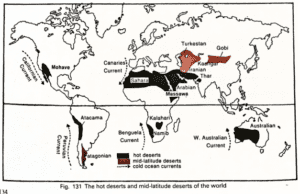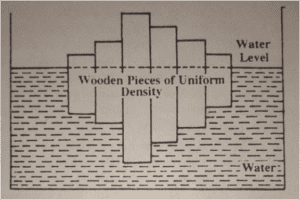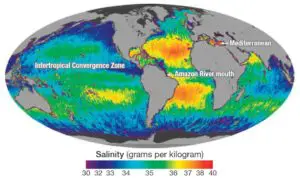Table of Contents
Origin and Interior of the earth and Age of Earth | UPSC – IAS
Origin of Earth and Universe
The origin of Earth, and indeed of the universe, is incompletely understood. It is generally accepted that the universe began with a cosmic event called the big bang. The most widely held view is that the big bang took place some 13.7 billion years ago – similar to the age of the oldest known stars.
- The big bang began in a fraction of a second as an infinitely dense and infinitesimally small bundle of energy containing all of space and time started to expand away in all directions at extraordinary speeds, pushing out the fabric of space and filling the universe with the energy and matter we see today.
- Origin of Our solar system originated between 4.5 and 5 billion years ago when a nebula – a huge, cold, diffuse cloud of gas and dust – began to contract inward, owing to its own gravitational collapse, forming a hot, dense protostar.
- This hot center “our Sun” was surrounded by a cold, revolving disk of gas and dust that eventually condensed and coalesced to form the planets.
Image Explanation – The origin of the solar system. (1) Diffuse gas cloud, or nebula, begins to contract inward. (2) Cloud flattens into nebular disk as it spins faster around a central axis. (3) Particles in the outer parts of the disk collide with each other to form protoplanets. (4) Protoplanets coalesce into planets and settle into orbits around the hot center. (5) The final product: a central Sun surrounded by eight orbiting planets (solar system not shown in correct scale). The original nebular disk was much larger than our final solar system.
All of the planets revolve around the Sun in elliptical orbits, with the Sun located at one focus (looking “down” on the solar system from a vantage point high above the North Pole of Earth, the planets appear to orbit in a counterclockwise direction around the Sun).
- All the planetary orbits are in nearly the same plane, perhaps revealing their relationship to the original spinning direction of the nebular disk. The Sun rotates on its axis from west to east.
- Moreover, most of the planets rotate from west to east on their own axes (Uranus rotates “sideways” with its rotational axis almost parallel to its orbital plane; Venus rotates from east to west). The planets revolve more slowly and generally have a lower temperature as their distance from the Sun increases.
 Image Explanation – The structure of the Milky Way Galaxy showing the approximate location of our Sun on one of the spiral arms.
Image Explanation – The structure of the Milky Way Galaxy showing the approximate location of our Sun on one of the spiral arms.
The Planets – Inner and Outer | UPSC – IAS
Inner Planets
- The four inner terrestrial planets Mercury, Venus, Earth, and Mars – are generally smaller, denser, and less oblate (more nearly spherical), and
- They rotate more slowly on their axes than the four outer Jovian planets – Jupiter, Saturn, Uranus, and Neptune. Also, the inner planets are composed principally of mineral matter and, except for airless Mercury, have diverse but relatively shallow atmospheres.
Outer planets or Jovian Planets or Giant Planets
By contrast, the four Jovian planets tend to be much larger, more massive (although they are less dense), and much more oblate (less perfectly spherical) because they rotate more rapidly. The Jovian planets are mostly composed of elements such as hydrogen and helium – liquid near the surface, but frozen toward the interior – as well as ices of compounds such as methane and ammonia.
The Jovian planets generally have atmospheres that are dense, turbulent, and relatively deep. It was long thought that tiny Pluto was the ninth and outermost planet in the solar system.
- In recent years, however, astronomers have discovered other icy bodies, such as distant Eris, Makemake, and Haumea that are similar to Pluto and orbiting the Sun beyond Neptune in what is referred to as the Kuiper Belt or trans-Neptunian region.
- In June 2008 the International Astronomical Union reclassified Pluto as a special type of dwarf planet known as a plutoid. Some astronomers speculate that there may be several dozen yet-to-be-discovered plutoids and other dwarf planets in the outer reaches of the solar system.
The Size and Shape of Earth | UPSC – IAS
Is Earth large or small? The answer to this question depends on one’s frame of reference. If the frame of reference is the universe, Earth is almost infinitely small.
The diameter of our planet is only about 13,000 kilometers (7900 miles), a tiny distance at the scale of the universe – For instance – The Moon is 385,000 kilometers (239,000 miles) from Earth, The Sun is 150,000,000 kilometers (93,000,000 miles) away, and the nearest star is 40,000,000,000,000 kilometers (25,000,000,000,000 miles) distant.
Image Explanation: Earth is large relative to the size of its surface features. Earth’s maximum relief (the difference in elevation between the highest and lowest points) is 19,883 meters (65,233 feet) or about 20 kilometers (12 miles) from the top of Mount Everest to the bottom of the Mariana Trench in the Pacific Ocean.
The Size of Earth | UPSC – IAS
In a human frame of reference, however, Earth is impressive in size. Its surface varies in elevation from the highest mountain peak, Mount Everest, at 8850 meters (29,035 feet) above sea level, to the deepest oceanic trench, the Mariana Trench of the Pacific Ocean, at 11,033 meters (36,198 feet) below sea level, a total difference in elevation of 19,883 meters (65,233 feet).
Although prominent on a human scale of perception, this difference is minor on a planetary scale. If Earth were the size of a basketball, Mount Everest would be an imperceptible pimple no greater than 0.17 millimeter (about 7 thousandths of an inch) high.
Similarly, the Mariana Trench would be a tiny crease only 0.21 millimeter (about 8 thousandths of an inch) deep— this represents a depression smaller than the thickness of a sheet of paper.
- Our perception of the relative size of topographic irregularities on Earth is often distorted by three-dimensional wall maps and globes that emphasize such landforms. To portray any noticeable appearance of topographic variation, the vertical distances on such maps are usually exaggerated 8 to 20 times their actual proportional dimensions – as are many diagrams used in this book. Further, many diagrams illustrating features of the atmosphere also exaggerate relative sizes to convey important concepts.
- More than 2600 years ago Greek scholars correctly reasoned Earth to have a spherical shape. About 2200 years ago, Eratosthenes, the director of the Greek library at Alexandria, calculated the circumference of Earth trigonometrically. He determined the angle of the noon Sun rays at Alexandria and at the city of Syene, 960 kilometers (600 miles) away. From these angular and linear distances he was able to estimate an Earth circumference of almost 43,000 kilometers (26,700 miles) which is reasonably close to the actual figure of 40,000 kilometers (24,900 miles).
The Shape of Earth | UPSC – IAS
- Earth is almost, but not quite, spherical. The cross section revealed by a cut through the equator would be circular, but a similar cut from pole to pole would be an ellipse rather than a circle. Any rotating body has a tendency to bulge around its equator and flatten at the polar ends of its rotational axis. Although the rocks of Earth may seem quite rigid and immovable to us, they are sufficiently pliable to allow Earth to develop a bulge around its middle.
- The slightly flattened polar diameter of Earth is 12,714 kilometers (7900 miles), whereas the slightly bulging equatorial diameter is 12,756 kilometers (7926 miles), a difference of only about 0.3 percent. Thus, our planet is properly described as an oblate spheroid rather than a true sphere. However, because this variation from true sphericity is exceedingly small, in most cases in this book we will treat Earth as if it were a perfect sphere.
Read – Earth’s Interior- Crust, Mantle and Core






